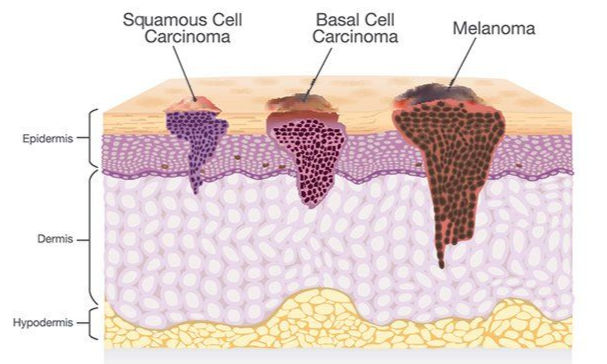Skin Cancer Awareness Month: Know the Signs, Protect Your Skin
- info479331
- May 18
- 2 min read

May marks Skin Cancer Awareness Month—a crucial time to spotlight the most common form of cancer worldwide. With cases continuing to rise, early detection is more important than ever. One of the best ways to protect yourself is by regularly checking your skin for unusual moles and blemishes. In this post, we’ll guide you through the main types of skin cancer and how to spot warning signs before they become serious.

How Skin Cancer Develops
Skin cancer usually begins when DNA damage from ultraviolet (UV) radiation (from sunlight or tanning beds) triggers mutations in skin cells. Over time, this damage accumulates, especially in sun-exposed areas like the face, neck, arms, and back. Those with fair skin, a history of sunburns, numerous moles, or a family history of skin cancer are at higher risk.
Types of Skin Cancer to Watch For

Basal Cell Carcinoma (BCC)
Most common form of skin cancer.
Grows slowly and rarely spreads, but can cause significant skin damage if untreated.
Look out for:
Pearly or waxy bumps
Flat, flesh-coloured or brown lesions
Sores that bleed, scab, or don’t heal

Squamous Cell Carcinoma (SCC)
Second most common type.
Can grow deeper and spread if not caught early.
Look out for:
Scaly, red patches
Firm bumps or nodules
Crusted sores that don’t heal
Melanoma
Most dangerous form due to its ability to spread quickly.
Early detection is critical.
Look out for:
Changes in size, shape, or colour of moles
New, unusual growths
Moles that itch, bleed, or become tender

How to Check Your Moles: The ABCDE Rule
When examining your skin, use the ABCDE guide to assess moles:
A – Asymmetry: One half doesn’t match the other
B – Border: Edges are irregular, blurred, or ragged
C – Colour: Multiple shades or uneven colouring
D – Diameter: Larger than 6mm (about the size of a pencil eraser)
E – Evolving: Changes in size, shape, or symptoms (like itching or bleeding)

When to Seek Professional Advice
Not all skin changes are dangerous—but if something looks or feels off, don’t ignore it. Early diagnosis can make all the difference. If you notice a suspicious mole or blemish:
Don’t try to remove it yourself
Take a clear photo to track changes
Book a dermatology check or use a trusted mole screening service like Map My Mole
Take Action This Skin Cancer Awareness Month
Protecting your skin is a lifelong commitment. Here are some tips to reduce your risk:
Wear SPF 30+ sunscreen daily—even on cloudy days
Avoid peak sun (10am–4pm)
Wear hats, sunglasses, and protective clothing
Avoid tanning beds entirely
Check your skin monthly in good lighting
Early detection saves lives. Use this month as a reminder to get familiar with your skin, share awareness, and take proactive steps to stay safe.
If you’ve noticed a mole or skin change you’re unsure about, Map My Mole offers expert assessment from dermatology professionals—so you can move forward with confidence and peace of mind and this service is now available at Complete Beauty.
Find out more HERE on how map my mole works or book your appointment today.









Comments